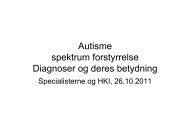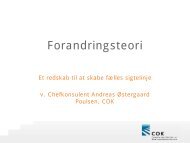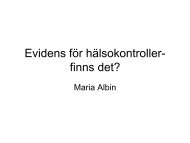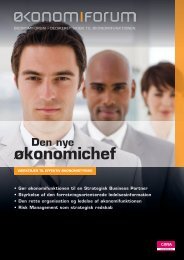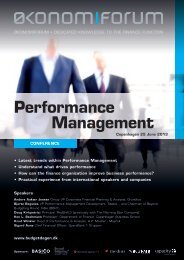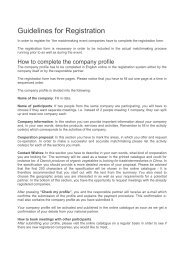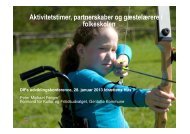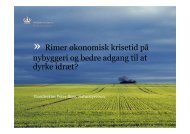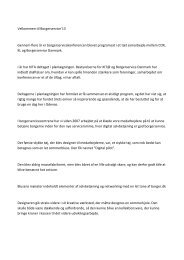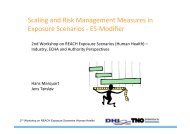Eriksholm Summer Camp, 18-22 August 2010
Eriksholm Summer Camp, 18-22 August 2010
Eriksholm Summer Camp, 18-22 August 2010
Create successful ePaper yourself
Turn your PDF publications into a flip-book with our unique Google optimized e-Paper software.
10<br />
So how does today’s hearing care professional<br />
survive and thrive in this changing marketplace<br />
“Meet the Moderns” is a presentation that sheds<br />
new light on today’s consumers with particular emphasis<br />
on first time users. The insights are the result<br />
of Oticon’s recent and unique worldwide consumer<br />
survey based on nearly 1,500 consumers with hearing<br />
loss, revealing new insight into why people don’t<br />
come in - and why they walk out.<br />
Are we doing everything we can to help more people<br />
own their hearing loss Learn more about several<br />
new areas of opportunity for us to close the gaps<br />
between people’s needs and expectations vs. what<br />
we are doing as an industry today.<br />
Life at Oticon<br />
Ole Fogh Olsen, Director of Audiology &<br />
Algorithms, Oticon A/S<br />
An introduction to Oticon and daily life at the company.<br />
How can audiologists - who are educated to<br />
help patients cope with hearing loss – actively contribute<br />
to hearing aid development This short presentation<br />
of how hearing aids are developed will give<br />
you an idea of how important it is for audiologists to<br />
be represented in the development process. You will<br />
learn about the different tests that we run and the<br />
large panel of test subjects that try our products<br />
before they are released for sale.<br />
Trends in Audiology<br />
Joel Beilin, Senior Director of Audiology &<br />
Algorithms, Oticon A/S<br />
During the last few years Oticon has been investing<br />
a significant effort into understanding, developing<br />
and implementing spatial sound technologies into<br />
hearing instruments. As part of this focus, a brand<br />
new advanced Virtual Sound Environment laboratory<br />
was created at Oticon’s Headquarters. But why<br />
is spatial sound suddenly so interesting Actually<br />
it always has been, but due to technological limitations<br />
as well as a limited understanding of the<br />
underlying cognitive and perceptual mechanisms, it<br />
is only recently that a more comprehensive understanding<br />
of spatial perception and sound reproduction<br />
has been gained. We know that disabilities in<br />
dynamic and spatial hearing can affect people’s perception<br />
of hearing loss, and even though hearing aid<br />
technology has come a long way in terms of speech<br />
understanding in noisy surroundings - as measured<br />
in a laboratory setup – the fact is that truly spatial<br />
environments remain a major challenge, particularly<br />
where speech is being compromised by noise.<br />
Evaluation and Management of Tinnitus<br />
Ravi Sockalingam, Senior Audiologist, Oticon A/S<br />
Tinnitus is a common complaint among people with<br />
hearing loss and yet very little is taught at most<br />
audiology curricula. As a result many clinicians feel<br />
ill-equipped or under-prepared to take on tinnitus<br />
clients in their clinical practice. This presentation<br />
aims to walk the audience through a range of tools<br />
and techniques that are available to audiologists<br />
for evaluating and managing tinnitus effectively in<br />
a clinical setting. As in most types of psychological<br />
rehabilitation, there is no “one size fits all”. Every<br />
patient is unique and the type of remediation for a<br />
particular patient may encompass a combination of<br />
several techniques and approaches.<br />
Silicon Engines – the Heart of Hearing Solutions<br />
Ivan Jørgensen, Director of Silicon Engines,<br />
Oticon A/S<br />
The presentation introduces the technologies used<br />
to build the electrical core of modern hearing aids.<br />
We also take a look at the latest trends.<br />
ACCESS: A user-driven approach to designing new<br />
hearing aid accessories<br />
Gabriel Aldaz, Mechanical Engineering Industrial<br />
PhD student<br />
Oticon’s new corporate strategy states that people<br />
are our starting point. The ACCESS project, which<br />
took a user-driven approach to designing hearing<br />
aid accessories, is an excellent example of this<br />
philosophy. The project team (three CDT members<br />
plus internal and external consultants) sought to<br />
answer the research question, “In what situations<br />
are hearing aids alone not enough to provide a good<br />
user experience” Over the course of one year we<br />
gathered user insights, analysed them, and created<br />
a number of innovative accessory proposals that<br />
might one day become real products on the market.<br />
Keys to success - what to consider before, during,<br />
and after fittings<br />
Regitze Willemoës, Audiologist/International<br />
Trainer, Oticon A/S<br />
Successful fittings demand a holistic aproach and a<br />
thorough understanding of patient needs. We will<br />
discuss your potential everyday challenges and<br />
offer ways to overcome these with the aid of supportive<br />
fitting and counselling tools.<br />
Children with hearing loss – who are they and how<br />
can we help<br />
Sille Ørnberg, Marketing Group Manager, Paediatrics,<br />
Oticon A/S<br />
The presentation addresses the paediatric segment<br />
and shows the areas in which children with hearing<br />
loss differ from adults. What do we need to consider<br />
when working with children, and how can we help<br />
them with amplification and accessories<br />
Saturday’s exhibitions<br />
Oticon Medical<br />
Anton Hedström & Heidi Kofod<br />
At Oticon Medical over a century of experience in<br />
audiology and sound processing is being combined<br />
with decades of pioneering experience in hearing<br />
implant technology. Our connection to Oticon gives<br />
us unique access to knowledge, resources and<br />
technology, as well as the power to bring progression<br />
to bone anchored hearing systems.<br />
Oticon Medical’s People First philosophy is a direct<br />
heritage from Oticon. It reminds us that every<br />
product we create – from sound processors and surgical<br />
components to fitting, counselling and support<br />
tools – should be designed with user needs in mind.<br />
We want to empower all users of bone anchored<br />
hearing systems to realise their full potential and<br />
play an active part in life.<br />
Interacoustics<br />
Maria Løye Samsson<br />
RECD (Real-Ear-to-Coupler Difference) is an important<br />
tool in clinical practice - especially when having<br />
to deal with children - as their ear canals are smaller.<br />
If adult data is used in the fitting process there is a<br />
risk of providing too much amplification. Furthermore,<br />
RECD overcomes the problem associated with<br />
changes in azimuth and movement of the reference<br />
microphone that may occur when dealing with hardto-test<br />
populations. Even though RECD has many<br />
advantages, many clinicians choose not to perform<br />
the measurement as they are uncertain about the<br />
procedure. This session is designed to address this<br />
issue and to demonstrate RECD on the Interacoustics<br />
Affinity2.0.<br />
Phonic Ear<br />
Pernille K. Lindhardt<br />
Phonic Ear and assistive listening devices. A short<br />
presentation of Phonic Ear as a company; a more<br />
detailed presentation of the products and solutions;<br />
plus a chance to see and try the products.<br />
11




